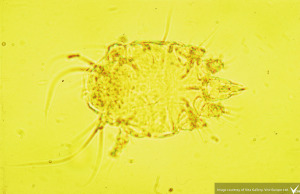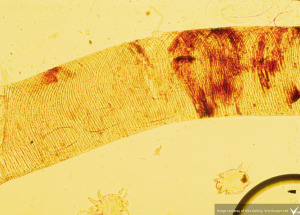Tracheal Mites
Acarapis woodi
Description
Found in the United States in 1984, tracheal mites decimated the American beekeeping industry for many years after its introduction. During those first years, beekeepers had losses in the tens of thousands with 75-100% winter loss. While no longer a major cause of honey bee death in the U.S., tracheal mites are still found in certain populations of bees, particularly in the temperate north.
Etiology
Tracheal mites are parasitic organisms that feed and reproduce in the respiratory system of adult honey bees.
They are obligate parasites and cannot survive more than a few hours away from their host. Female mites enter the spiracles of less than 3 day old adult bees. From the spiracles, the mites travel to the tracheae and begin to lay eggs. One female will lay approximately 8-10 eggs during her lifetime. Once hatched, the new mite will go through a larval and nymph stage before maturing into an adult after 11-12 days for males and 14-15 days for females. Females will mate with nest mates once they have matured. These mites live all stages of their lives exclusively in the tracheae of bees, except when mated females leave their host to seek out a new younger bee to start the process over again. On occasion, a second generation of females will mate and reproduce in their original host, as is often the case during a winter cluster when brood is not actively being reared.
Symptoms of a tracheal mite infestation are not unique to the parasite and include: increased winter loss and slow build up in the spring, a reduction in honey production, abnormal clustering in the winter, K-wing, fecal spots on the hive entrance, crawling bees found in front of the hive that are unable to fly, and premature death.
Spread and Control
Tracheal mites are actively spread when bees come into contact with one another. Mated female mites are able to sense the cuticular hydrocarbons of adult bees that are 1-3 days old. These mites are not found on comb. Spread throughout an apiary occurs through drifting, robbing, and swarming.
The only positive way to confirm a case of tracheal mites is through dissection and examination of the tracheal system.
Requeening is a very good non-chemical method of control and there are several lines of bees that have shown resistance or increased grooming behavior. Other methods would include employing menthol or grease patties in the hive.



